There are road trips, then there’s a road trip in Namibia. Despite being one of the least populated countries in the world, Namibia is overflowing with jaw-dropping attractions. Whether you want to explore a ghost town overtaken by sand dunes or spot lions on safari, a road trip through Namibia has an activity for you.
As soon as you’ve decided to visit Namibia, start determining your route. Figuring out how to fit everything you want to see in the time you have is a challenge.
We chose to do a two week self-drive trip around Namibia. We packed it very full. In retrospect, we should have added a few days to break up some long drives. Our top tip? Keep distances in mind as you plan because Namibia is larger than you think.
In this post, we’re sharing the itinerary we used for our self-drive tour of Namibia. We’re assuming that you, like us, are opting for a road trip. We’ll explain why we chose to go where we did, and provide insight on the stops that were better than anticipated, as well as those that didn’t meet our expectations.
The Route
Our trip took us counter-clockwise around the country. We started in Windhoek, then drove to Etosha, the Skeleton Coast, Swakopmund, Sesriem/Sossusvlei, Lüderitz and Fish River Canyon, before heading back to Windhoek for a night. Including our arrival and departure, we were in the country for a total of thirteen days.
Itinerary Overview
- Day One: Arrival & Windhoek
- Day Two: Africat & Etosha
- Day Three: Eastern Etosha
- Day Four: Western Etosha
- Day Five: Twyfelfontein & the Skeleton Coast
- Day Six: Skeleton Coast & Swakopmund
- Day Seven: Walvis Bay, Solitaire & Sossusvlei
- Day Eight: Sossusvlei
- Day Nine: Duwisib Castle & Lüderitz
- Day Ten: Elizabeth Bay & Lüderitz Peninsula
- Day Eleven: Fish River Canyon
- Day Twelve: Return to Windhoek
- Day Thirteen: Departure
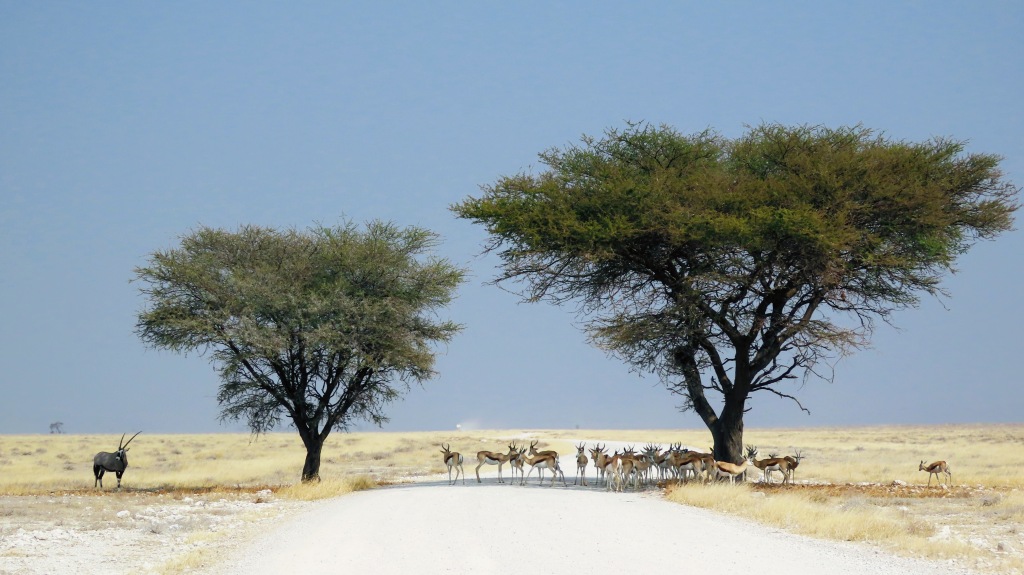
Day One: Arrival & Windhoek
Morning – International flights to Windhoek arrive at the Hosea Kutako International Airport, located about 40 kilometers from the city center. If you are renting a vehicle to do a self-drive, your rental company should provide an airport transfer service. Before leaving the airport, stop at an ATM for some cash and grab a SIM for your phone from the MTC store right by the exit. Your next stop is your rental company’s offices to learn how your car works and go through the paperwork. This takes between one to two hours.
Afternoon – If you plan on camping, head out to get groceries. We highly recommend the Superspar at The Grove Mall. It’s an incredibly well-stocked supermarket and we loved its large biltong, game meat and wine selections. The Grove Mall also has lots of restaurants where you can grab a quick bite to eat. You’ll find everything from all-day breakfast at Mugg & Bean to loaded burgers at Santa Fe Grill.
Afterwards, head to your hotel to check in. For our first night, we stayed at The Olive Grove Guesthouse in Eros, a posh neighborhood to the northeast of downtown. We loved the central location and the relaxing outdoor patio. Check out our full review for details and photos.

Evening – Explore central Windhoek. The city is spaced out, a bit like LA, and you’ll want plenty of time to get around. From our hotel, it took us just thirty minutes to walk to the city’s iconic Christus Kirche. Aim to visit just before sunset for golden hour when the church takes on a storybook appearance. Built between 1907 and 1910, the church was originally known as the Church of Peace following Germany’s war against the Herero, Owambo, and Khoikhoi peoples (now largely considered to be a genocide and precursor to the holocaust). It’s rarely open to visitors.
Be sure to visit the Independence Museum while you’re there. The metallic edifice was designed and built by a North Korean firm in 2014 to mark the 20th anniversary of Namibia’s independence from South Africa. Inside, you’ll find a sobering survey of Namibia’s history, tracing the colonial resistance against German and South African rule.
For dinner, book a table at Joe’s Beerhouse. This restaurant is a Windhoek institution. The eclectic interior mixes old farm equipment and safari paraphernalia to a surprisingly cozy effect. It’s also a great place to sample Namibia’s array of game meats, from kudu to zebra, which pair perfectly with an icy Windhoek draught. Emilia also appreciated the resident cats, one of whom tried to steal a bite of her sausage.
Day Two: Africat & Etosha National Park
Morning – Wake up between 6:45 and 7:00am to indulge in a cooked breakfast at your hotel. If you’re on the road by 8:00am, you’ll be able to stop for a mid-morning game drive at Okonjima Nature Reserve. Okonjima is home to the Africat Foundation, which is dedicated to protecting Namibia’s big cats. There’s an 11:00am and 1:00pm tour for day visitors, which gets you up-close-and-personal with the reserve’s rescue cheetahs.
The reserve also offers a reasonable set lunch for day visitors, though if you’re camping at Etosha, you may want to opt for a road lunch to ensure you can set up your campsite during the daylight.
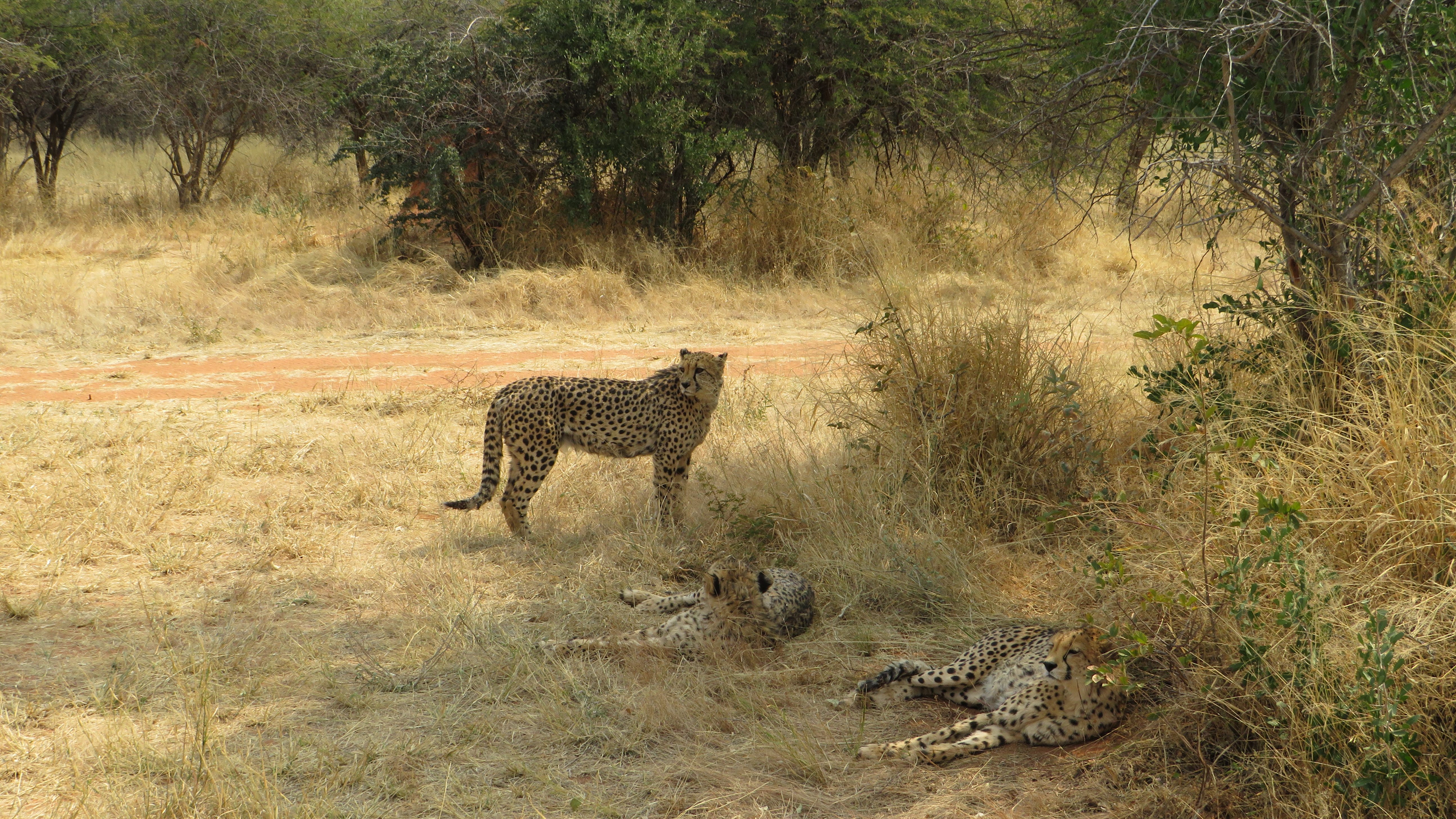
Afternoon – Your afternoon will be spent driving to Etosha National Park, which is a total of 415 kilometers from Windhoek and 235 from Okonjima. All of the roads you’ll be driving on today are tarred, which makes your first day of left-hand driving easier. As you continue, the roads get progressively emptier, giving you a taste of what you’ll encounter in the second half of your Namibia trip.
You arrive in Etosha via the Anderssen Gate. From there, head to Okaukuejo resort, where you pay your entrance fee. Keep the receipt handy as you’ll need to show proof of payment to leave the park.
Evening – For our first night, we stayed at Halali, which is about an hour and a half drive from Okaukuejo. You’re not allowed to drive within the park between sunrise and sunset. The gates to the resorts within the park close overnight, meaning you’ll need to reach Okaukuejo with over an hour and a half to spare if you’re staying at Halali on your first night.
No matter where you stay, every resort has a waterhole visible from within the grounds, which you should visit in the evening. Bring a pair of binoculars and a camera and get ready to watch a nature video unfold in real time in front of you.
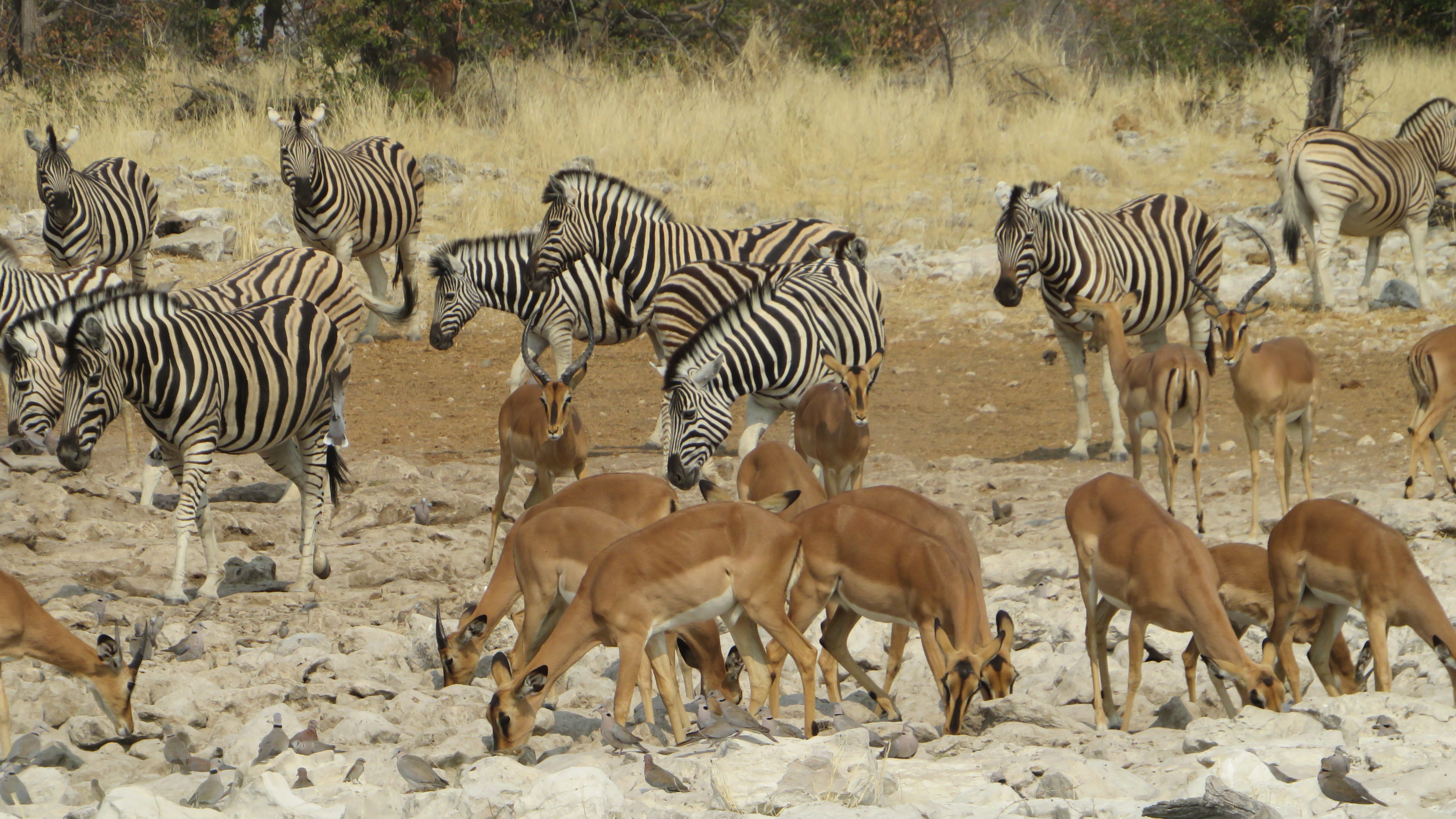
Day Three: Eastern Etosha
Morning – Set your alarm so you’re ready to go as soon as the gates to your resort open – in late August this is around 7:15am. Animals prefer the cool early morning to the toasty midday. The morning, immediately after sunrise, is one of the best times for seeing big game.
Before you head out, we recommend stopping by reception to book an early morning game drive for the following day. This offers a unique chance to see Etosha before sunrise, and is one of the best times of day for spotting big cats.
Spend your first day touring Etosha’s eastern reaches. Your aim is to reach Namutoni Lodge in time for a self-catered lunch. Along the way, turn into any waterhole you see a sign for.
When you reach Namutoni, explore the grounds. This resort is characterized by the German fort in its center. It was built in the early 20th century as a police station, before being turned into a military training center.
Afternoon – Drive back to your lodge, visiting any waterholes you skipped in the morning. This is the slowest time of day for animals. If you feel your energy waning, skip the waterholes and relax poolside before the early evening. We advise heading out to visit a waterhole or two around 5:00pm as the sun lowers and the temperature dips.
Evening – Whether you’re cooking or having dinner at the lodge’s restaurant, save time for the waterhole at your camp. You never know what will be there! One night we saw rhinos and elephants in a standoff, while a leopard snuck in next to a rhino to get a drink.

Day Four: Western Etosha
Morning – Start your day bright and early with a pre-dawn game drive (usually starting at 6:30). These last for about an hour and a half. Bundle up. The air temperature might be bearable, but the winds whipping off the pan will make you shiver.
Back in your car, head towards the west of the park. Plan your route so that you reach Okaukuejo in time for a self-catered lunch.
Afternoon – If you feel like heading out in the afternoon, traverse the far western side of the pan. The desolate environment makes any animals you spot even more memorable. We saw a lion sitting under a lone tree in the middle of an open field here.
Evening – Keep your evening routine the same: dinner and waterhole.
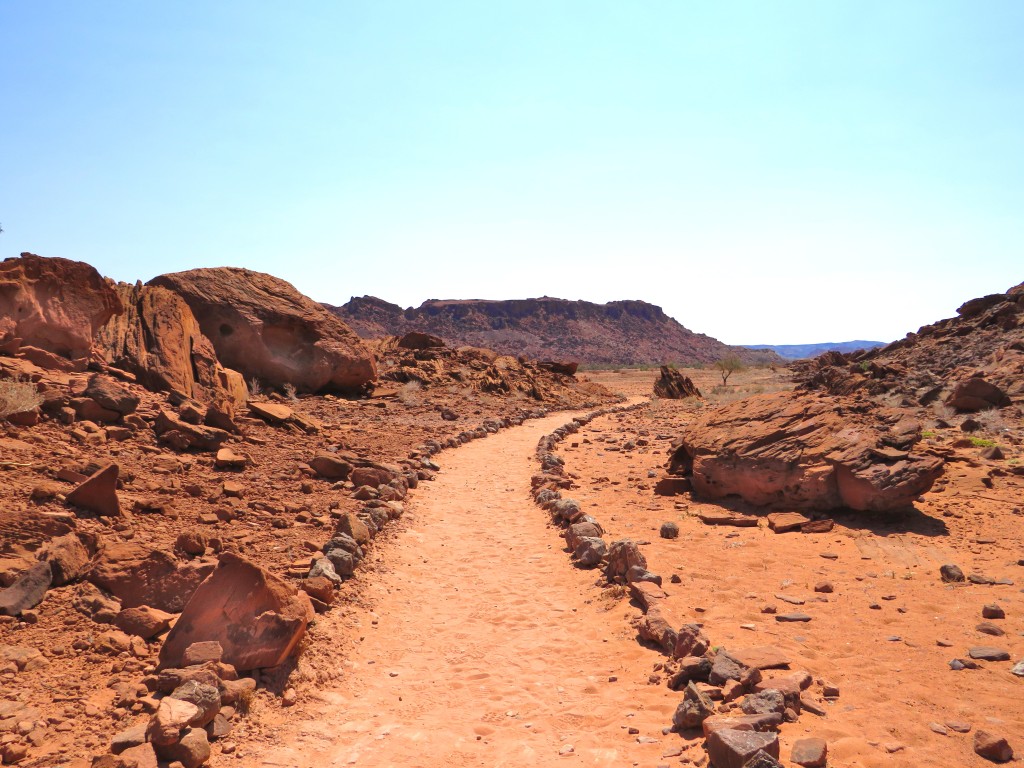
Day Five: Twyfelfontein & the Skeleton Coast
Morning – Set your alarm to 6:45am. You’ll be travelling 492 kilometers today to the Skeleton Coast. This isolated national park covers Namibia’s northern coast, though only a small portion of it is accessible to visitors.
Break up the drive with a stop at one of the many attractions in Damaraland. We went to Twyfelfontein, where you’ll go on a 30-minute guided hike to see engraved rocks dating back over 2,000 years. The engravings are remarkably well-preserved despite laying in the open air for thousands of years.
Other stops along your drive include the Petrified Forest, which is just off the C39. Or stop by the Damara Living Museum to learn about the region’s indigenous people. If you have time, Damaraland can become a whole day stop over.
Afternoon – If you continue to the Skeleton Coast, you’ll want to be on the road no later than 2:30pm to give yourself enough time to make it to Springbokwasser gate (and your hotel) without rushing. While the gate closes at 3:00pm for those passing through the park, people with bookings at Torra or Terrace Bay may enter through the gate up to 5:00pm.
Both Torra Bay and Terrace Bay are NWR properties that are well-loved for their fishing. Terrace Bay offers private, catered chalets and is located at the far north of the public-access road, any further north and you need a permit. Torra Bay is a campsite located further south, but is only open between December and January. They’re both Namibian institutions: Terrace Bay was a favorite of former president Sam Nujoma and Torra Bay is known to be booked a year in advance.
Once inside Springbokwasser gate, take your time getting to your destination. Park on the side of the road and enjoy the silence, or see if you can spot any animals at the water hole by the Uniab river (we couldn’t). By Terrace Bay, there are also some 4×4 trails for dune driving. We didn’t try them, so can’t speak to their quality, but the main roads in the Skeleton Coast are overall very well kept – see our roads guide for details.
Evening – Spend the evening enjoying the edge-of-the-world isolation. Walk around the rock beach, then watch the sunset from your campsite or porch. If staying at Terrace Bay, dinner is included in the booking price. It’s taken at the quirky restaurant-meets-bar, where the ceilings and walls are covered in scrawled notes from infatuated guests over the years.

Day Six: Skeleton Coast Shipwrecks & Swakopmund
Morning – Get on the road by 8:00am. You’ll want time to stop by the Skeleton Coast’s shipwrecks.
Approximately 62 kilometers south of Torra Bay, you’ll pass through Toscanini. Despite being clearly marked on most maps, this abandoned oil drilling outpost is nearly impossible to spot from the road.
Ten kilometers further south, you’ll encounter the first wreck: an abandoned oil rig. As you continue down the coast look out for the well-marked Winston wreck. Depending on how much time and motivation you have, a few additional unmarked wrecks can also be found if you have pre-marked GPS coordinates.
Afternoon – For lunch, either make sandwiches when you stop by the Winston or snack as you drive to your next destination, the Cape Cross Seal Reserve. While the entrance fee is relatively steep, we promise the sight of thousands of seals sprawling over the beach is worth it. There’s a viewing platform so you can look at the seals from above. The day we visited, someone left the gate open and the viewing platform was covered in seals. The smell is…distinctive, and the noise the seal pups make sounds like half-hearted screams.

Back in your car, continue heading south to Hentiesbaai. Stop along the route to buy gemstones at the stands along the side of the highway (they’re unmanned and use the honor system). If you need gas, stop in town to fill up. Otherwise, continue toward the Zelia, a shipwreck located about 14 kilometers to the south. This Angolan fishing trawler ran ashore in 2008 as it was being pulled toward India to be sold as scrap. It’s one of the best preserved wrecks that can be easily reached, but the parking lot has a reputation for pushy gemstone sellers.
Evening – By the time you arrive in Swakopmund, it’s likely to be early evening. Check into your hotel – we recommend Hotel A La Mer, a modern property located steps away from the jetty and palm tree-lined waterfront promenade.
Seize golden hour for a walking tour of the city’s oldest and best-preserved buildings. If you time everything right, you’ll end up at the Mole for sunset.
For dinner, we opted to eat at Brewer & Butcher, a restaurant-meets-craft-brewery located in the well-heeled Strand Hotel. It’s an excellent option with a fantastic range of dishes (try the lamb stew!). We’ve also heard wonderful things about Jetty 1905, which is well-known for its local seafood, though it was closed when we visited.


Day Seven: Walvis Bay, Solitaire & Sossusvlei
Morning – Arrive at your hotel breakfast as soon as it begins, typically around 7:00am. If you need to stock up on groceries, head to the Superspar in the city center. We also recommend filling up your gas tank at any of the filling stations in town.
Speed down the tarred B2 to Walvis Bay, which should take no more than 30 minutes to traverse. Head directly to the waterfront promenade. This tranquil promenade is a popular exercise spot for locals, and also an excellent place for seeing Walvis Bay’s famous flamingos. Over the course of a year, upwards of 150,000 flamingos may pass through. Continue down the promenade to Safe Viewpoint 1 or 2 for a less-trafficked view of the lagoon and flamingos.
Afternoon – Take an early lunch at Anchors @ the Jetty, a waterfront restaurant that offers super-fresh fish dishes, as well as tasty burgers. When you park in the adjacent lot, you’ll likely be offered car watching services by a local. Take them up on their offer: it’s a common local practice and shouldn’t cost you more than a dollar to reward (tipping is customarily done as soon as you arrive, or after if you accept their offer to wash your car).

After lunch, it’s time to tackle the drive to your lodging around Sesriem, where Sossusvlei is located. The roads on this route were some of the bumpiest we encountered in Namibia, but you are rewarded with spectacular scenery. Over three hours, you’ll traverse two canyon passes, cross the Tropic of Capricorn and swing through Solitaire. This small town is barely a dot on the map, but has become a requisite tourist stop and can get quite crowded. Pro tip: skip the cafe and head straight to the general store to pick up some baked goods for a post-camp dinner treat.
Evening – After a few more hours driving, you’ll arrive at the lodging around Sossusvlei. We think everyone should book one of the NWR properties located inside the park gates. These are the only lodging options in the area that give you pre-dawn and post-sunset access to the park, ensuring that you can watch the sunrise and sunset from the dunes.
We opted for Sesriem Campsite. If you’re lucky, you’ll get one of the original ten pitches, which feature a circular stone barrier and are located on the edges of the camping area. All pitches come with an acacia tree for shade.
The other option is the Sossus Dune Lodge, a luxury property that allows guests to bypass the park gate entirely for sunrise and sunset viewing.
No matter where you stay, be sure to save time in the evening for stargazing. The area is located near a dark sky reserve – you’re nearly guaranteed to see the milky way!

Day Eight: Sossusvlei
Morning – This will be the earliest morning of your trip. If you’re staying at Sesriem Campsite or Sossus Dune Lodge, you’ll be able to access the park a full hour before the external gates open. In other words, you’re entering one hour before sunrise. Be in your car at the inner gates as soon as they open.
Once inside the park, you’ll drive for about 40 kilometers (with a 60 km/hr speed limit, although most drivers go faster) to reach Dune 45, noted for its sunrise viewing point. This dune is a short, steep climb. Pace yourself and you’ll be rewarded with amazing vistas up and down the desert pan.
Your next stop is Deadvlei. This iconic clay pan is well-known for the dried-out trees that decorate the desiccated river bed like sculptures. To reach it, you’ll need to drive over sand in your 4×4, then hike for one km. Check out our guide and video for all the details you need to avoid getting stuck in the sand.
We advise visiting Deadvlei early in the morning to avoid the scorching sun and appreciate the long shadows against the trees. If you’re feeling ambitious, you can also climb Big Daddy Dune. This is the tallest dune in the park, measuring 350 meters. It’s a strenuous climb and one that’s best accomplished before the heat of the day.
After Deadvlei, it’s a further kilometer drive to Sossusvlei. This larger vlei is occasionally filled with water, as it was when we visited! Because of this, it’s also an excellent place for spotting wildlife.
You can also visit Hidden Vlei, which is a two kilometer hike from the 2×4 parking lot. If you found Deadvlei too crowded, Hidden Vlei may provide a more solitary experience.

Afternoon – As the heat intensifies, retreat to your car and back to your lodging. If you’re staying at the campsite, we advise stopping by reception and asking them to book you dinner at the nearby Sossus Dune Lodge. It’s a shockingly affordable, semi-luxe experience with the best food we ate at any NWR property.
Head over to Sesriem Canyon. The canyon extends for about one kilometer and has some stretches that hold water year-round. After you’ve taken some photos from above, look to your right, where you’ll find a well-trodden path that descends into the canyon. The temperature cools considerably as you descend. Spend time exploring the area, which boasts intriguing rock formations and fascinating bird life.
Evening – At 5:00pm, drive out to Elim Dune. Located just five kilometers inside the inner gate, this gently sloping dune offers an ideal perch for watching the sunset. While the climb isn’t as strenuous as Dune 45, we advise leaving between 45 minutes and an hour to reach the summit. There tend to be fewer people at sunset, making the experience all the more magical.

Day Nine: Duwisib Castle & Lüderitz
Morning – Set out from Sesriem at 7:30am, filling up your gas tank at the Engen Station located immediately outside of the park gates. It may look deserted, but wait for a few minutes and a worker on duty will come out to help.
Drive along the C27 for about two hours, before turning off onto the D826 to reach Duwisib Castle. Duwisib Castle was the home of a German landowner in the early 20th century and operates half as a museum, half as an NWR property today. Inside, be sure to take a peek into the courtyard, which is resplendent with bougainvillea and jacaranda trees.
Afternoon – You can continue along the C27 or opt to take the D707 to get to Lüderitz, which many say is one of the most scenic drives throughout the whole of Namibia. We’ll leave that up to you to decide. Over 125 kilometers you’ll pass through rocky mountains, open plains and sandy dunes. The road condition shifts at each point, making for a driving experience that’s nothing if not diverse.

Once you turn off the D707, you have a 55 kilometer drive until you reach Aus and the road becomes paved! Just a few kilometers after passing Aus, turn off the road for Garub, a water hole for feral horses. It’s extremely poorly marked, but you’ll know you’ve reached it when you see a paved turnoff on the right hand side of the road.
No one quite knows where the feral horses came from. The population has been declining since the 1990s. It’s hit or miss whether you’ll manage to see any when you stop by. Bring binoculars and scour the area if you don’t spot anything immediately. We thought there were no horses there, but it turned out that the four black dots we saw on the horizon were actually horses.
Evening – After Garub, it’s about an hour more until you reach Lüderitz. Check into your hotel, then head out to see the city’s key historic buildings. Like Swakopmund, the notable edifices are concentrated in a relatively small corner of town. Don’t miss a walk up the hill to view the Felsenkirche. If you arrive between 5:00pm and 6:00pm, the doors should be open and you can go inside.
For dinner, fish lovers should head to The Portuguese Fisherman. The menu gathers inspiration from Portugal and Japan (yes, there’s sushi) and the preparations are simple and delicious.
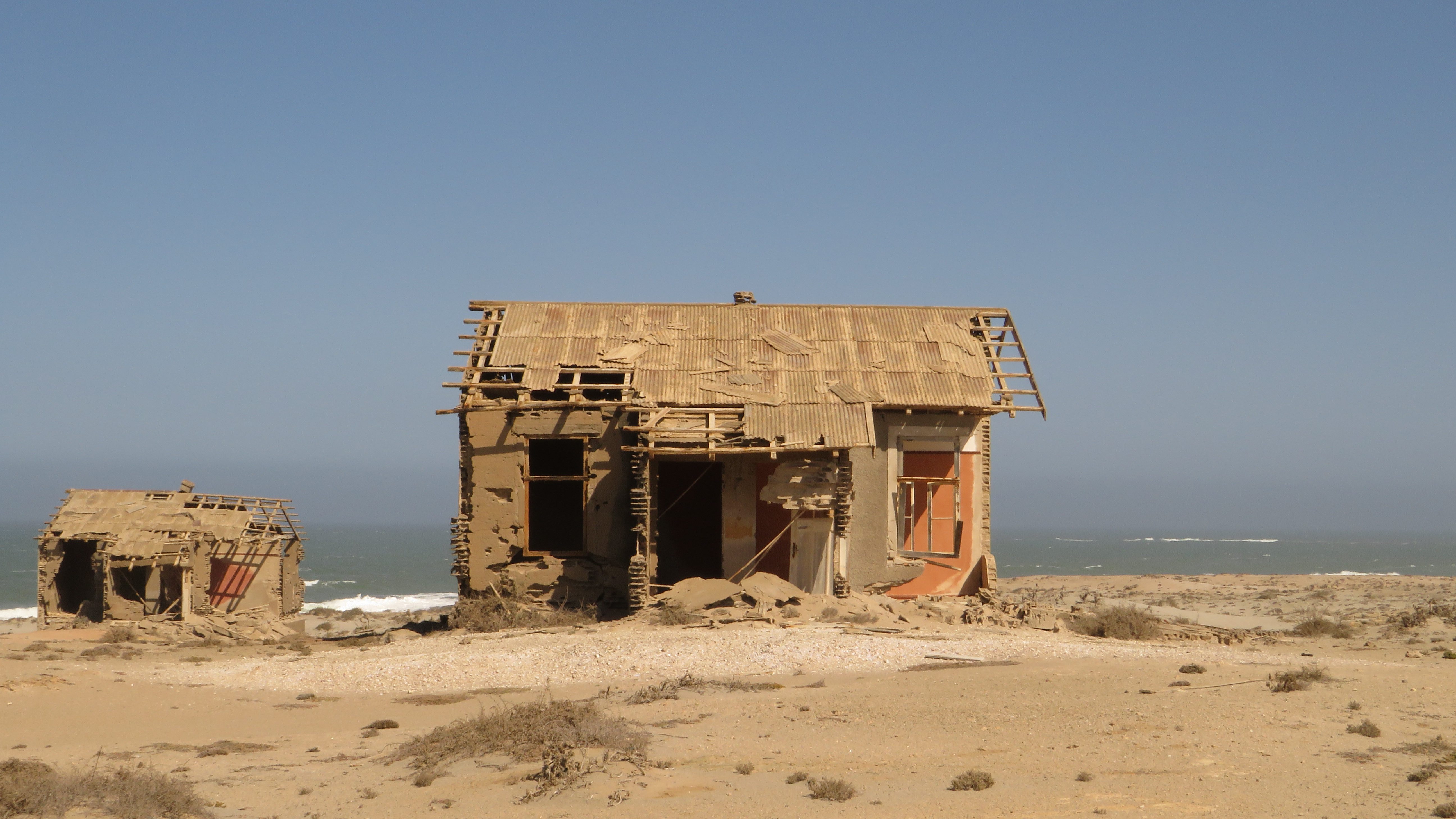
Day Ten: Elizabeth Bay/Kolmanskop & the Lüderitz Peninsula
Morning – If you’re interested in ghost towns and abandoned places, we highly recommend booking a tour of Elizabeth Bay with Namib Offroad Excursions. The town is located 25 kilometers inside the active diamond mining area, or Sperrgebiet, German for Forbidden Zone. In order to access it you’ll need to have pre-booked a tour. Elizabeth Bay was a diamond mining town that was active in the 1930s. When it was closed, it was left as is. All the decay you see was done at the hand of the elements. Watch our video tour for a sneak peek.
If you visit Elizabeth Bay, you’ll be able to walk around the former diamond mine, traipse through the buildings and get unique insight into what it was like to live in the town. It was one of the pricer excursions from our trip and worth every penny.
As an alternative you can visit Kolmanskop, another former diamond mining town. While Kolmanskop is also located inside the Sperrgebiet, it’s mere steps from the gate. Your entrance fee includes a tour. There are two per day, at 9:30am and 11am.


Afternoon – Follow decaying industry with some nature at the Lüderitz Peninsula. Located just a ten minute drive from town, this rocky protrusion faces the main city but has an enchanting windswept atmosphere. While most people visit simply to see Diaz Point – a rocky promontory where a Portuguese explorer landed in 1487 – spending a whole afternoon driving among the rocky inlets is enchanting.
Evening – Return to Lüderitz for sunset, then make your way to Barrels. This quirky two-story bar is a local institution. Order a beer and get comfy. The food is standard bar fare. If you’d prefer something nicer, head down to Essenzeit by the port.
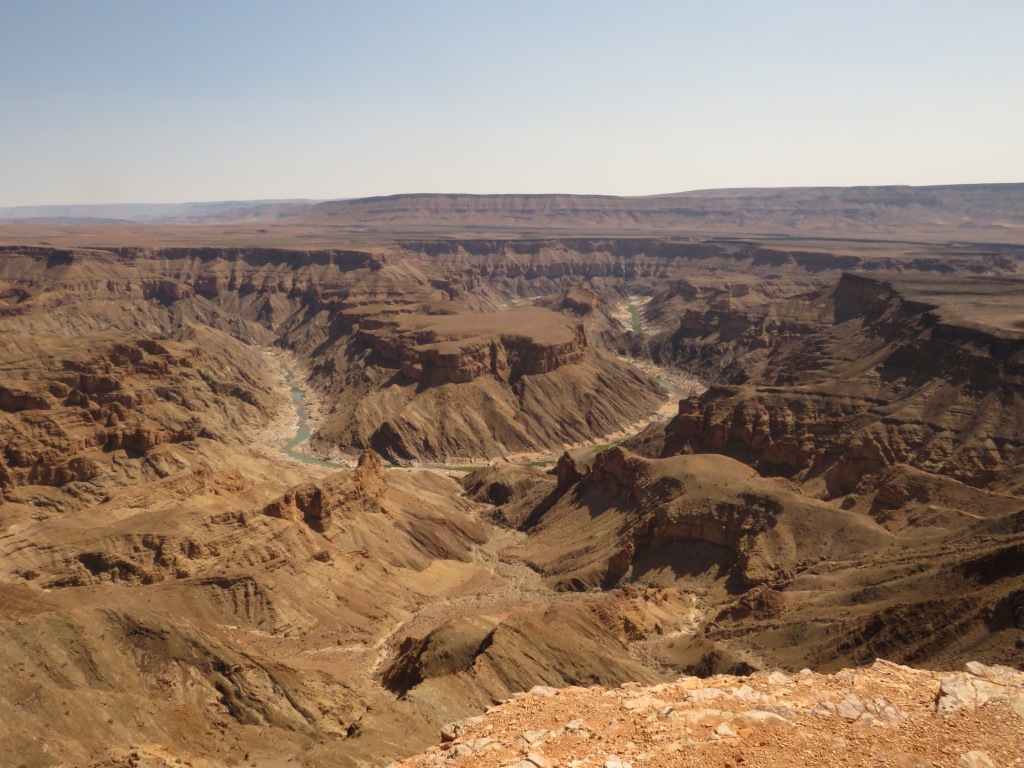
Day Eleven: Fish River Canyon
Morning – If you didn’t see Kolmanskop the previous day and want to see more ghost towns, arrive for the first tour as you head out of Lüderitz. Otherwise, get on the road early to make sure you have time at your next destination. Today’s drive is relatively short compared to some of the other scheduled routes, and the roads are in good condition. Take your time and stop when the mood strikes.
Some points of interest to watch out for include the Fish River (good for spotting wildlife), the Naute River Dam (which you’ll drive under) and Naute Kristall Distillery. Another curiosity is the Old Lime Oven, which is located a few minutes inside Gondwana Park. It’s easy to mistake this towering structure for an anthill from far off, but get closer and you’ll see it’s something else entirely. This oven was built in 1948 and was to heat lime, which was turned into cement and sold to construction companies.
Afternoon – Unlike other parks you’ll encounter during your trip, the gate to Fish River Canyon is always open (though you’ll still need to pay and show proof of payment to leave). This means that staying at an NWR resort isn’t strictly necessary for the best access times.
We stayed at Hobas Lodge within the park and loved it. The camping areas have amazing tree cover and well-equipped braais, not to mention some of the nicest bathrooms we saw during our trip.


It’s a quick drive from Hobas to Fish River Canyon. The main viewing point will be your first destination and it offers the best views, by far. You’ll be able to see the classic horseshoe bend and glimpse deep into the canyon. There are also some picnic tables for a scenic lunch.
Head to Hiker’s Viewpoint next. It’s the launching point for the gruelling five-day hike along the bottom of the canyon. While you won’t be undertaking anything so impressive, there are multiple rocky promontories that you can walk along to appreciate the canyon’s magnitude.
There are a handful of other viewpoints you can stop by, and they all offer slightly different views, some more remarkable than others. If you choose to visit them, know that the roads get horrendously, horribly rocky. To successfully navigate the trails labelled as 2-wheel drive, you’ll need a car with good ground clearance. Go slow to avoid any flats, and don’t be afraid to turn around if the going gets too tough. The main viewpoint is the best, we promise.
Evening – Evenings at Hobas are a quiet affair. You can book into dinner at the on-site restaurant, take a pre-sunset dip in one of the two pools, or simply chill out by your campfire. Spend some time looking at the stars, which rival what you saw at Sossusvlei in their brilliance.

Day Twelve: Return to Windhoek
Morning – Get on the road by 7:30am. The drive to Windhoek is long and, unfortunately, boring. While you’ll be driving over tarred roads for the vast majority of the way, they’re the busiest roads in Namibia. From Keetmanshoop to Windhoek, you’ll encounter countless trucks driving at their speed limit of 80 kilometers an hour. Passing them on a two-lane highway is a constant battle.
Afternoon – Take a break for lunch at one of Namibia’s plentiful roadside picnic spots, before arriving back in Windhoek. Do any last errands with your car, before returning it to your rental agency. Don’t forget to take a picture of the odometer to remember how far you drove!
For our second night in Windhoek, we chose to stay at The Windhoek Luxury Suites. While it’s a bit further from the downtown area, the property is impossibly serene. Wind down from your day of driving with a dip in the pool, or relax on your balcony with a drink.
Evening – Celebrate the end of your road trip with dinner at one of Windhoek’s best restaurants, the Stellenbosch Wine Bar. Bookings are essential. Ask for a table on the outdoor patio.


Day Thirteen: Departure
Depending on when your flight leaves, you might have some time for activities in the morning. Here’s our rundown of what to do:
- Go on a walking safari at the Daan Viljoen Game Park. Located just 24 kilometers outside Windhoek, this park hosts smaller game, but offers the opportunity to go on safari on foot. While seeing animals is never guaranteed, coming across wildlife on foot is exhilarating and immersive.
- Visit the Namibia Craft Centre. In the middle of downtown Windhoek, the Namib Craft Centre offers an astounding array of items made by regional craftspeople. Whether you want a hand carved wood rhino figurine, a hand-woven reed basket or one-of-a-kind art, you’ll find it here.
- Take a walking tour of Windhoek. To get a better grasp on the city, join a walking tour. This one from Chameleon Safaris covers all of the highlights in a half-day.
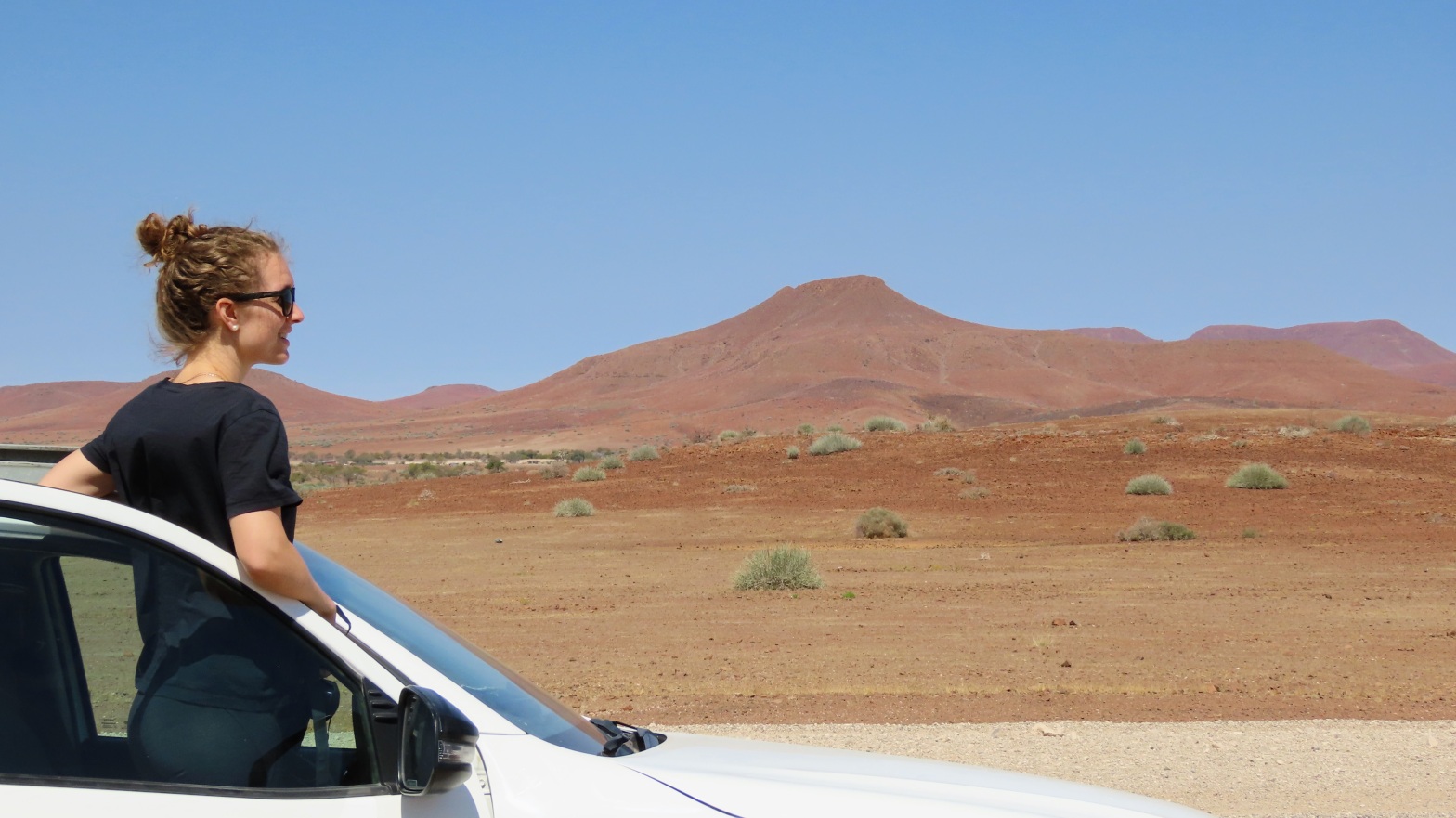
4 thoughts on “Complete Namibia Itinerary: A Two Week Self-Drive Adventure”